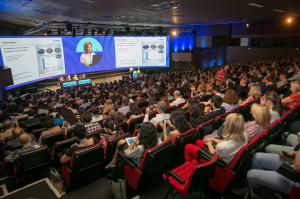The brain’s internal ‘GPS’ and time tracker provides valuable insight into Alzheimer’s disease, says Nobel Prize winner
Insights into complex, space-mapping and time-tracking neural systems that help us make sense of our experiences may give insights into Alzheimer’s disease.
The discoveries of how the brain encodes space, time and memory is of great importance to clinical neuroscience and the global efforts to fight brain disease.”
OSLO, NORWAY, June 28, 2019 /EINPresswire.com/ -- Nobel laureate Professor Edvard Moser, from the Norwegian University of Science and Technology in Trondheim, will inform attendees at the 5th European Academy of Neurology (EAN) Congress in Oslo, Norway that the loss of ability to find one’s way, to keep track of time and to create and retrieve memories are all hallmarks of Alzheimer’s disease and that a greater understanding of space and time mechanisms in the brain is of fundamental importance in neuroscience. — Professor Edvard Moser
“The neural networks that generate space and time are the very first cells that start to die, perhaps decades before we notice clear symptoms of Alzheimer’s Disease,” explained Professor Moser. “The discoveries of how the brain encodes space, time and memory is crucial to understanding how higher mental function is generated and of great importance to clinical neuroscience and the global efforts to fight brain disease.”
Professor Moser’s work on the breakthrough discovery of a positioning system in the brain, together with Dr May-Britt Moser and Professor John O’ Keefe of University College London, UK, was jointly awarded the Nobel Prize for Physiology or Medicine in 2014 and will be the main focus of his presentation. The grid cells which Professor Moser discovered in 2005, are referred to as the brain’s own GPS system that generate regular hexagonal patterns that cover our spatial environment and give information about distances and directions.
Professor Moser says the brain has several special types of navigation cells, each with an identifiable function. For example, there are place cells in the hippocampus, grid cells and object-vector cells (2019) in the medial entorhinal cortex, which provide an alternative or complementary way for people to find their way around.
There are also other specialist ‘speedometer’ cells to gauge speed of travel, head direction cells that act like an internal compass, giving a sense of direction and border cells, which set off neural alarms to alert you if you are near to the edge of something.
“The discovery of the brain's positioning system represents a paradigm shift in our understanding of how ensembles of specialised cells work together to execute higher cognitive functions. It has opened new avenues for understanding other cognitive processes, such as memory, thinking and planning,” says Professor Moser.
In patients with Alzheimer’s disease, the hippocampus and entorhinal cortex are frequently affected at an early stage, and these individuals often lose their way and cannot recognise their environment. Knowledge about the brain’s positioning system may, therefore, help with understanding the mechanism underpinning the significant spatial memory loss that affects people with this disease, Professor Moser will propose.
Professor Moser will also highlight the more recent discovery of a time code (2018) deep inside the brain that provides a sense of time in our experiences and memories.
Research carried out by Professor Moser and colleagues, including Albert Tsao, recorded the time signal from a neural network in the lateral entorhinal cortex (LEC). Professor Moser said: “This time code does not actually care about absolute (clock) time. It cares about sequence. What happened first, then what, and the next thing, and after that, etc. Just like the narratives of experience we continuously weave to make sense of the world around us. We believe that this discovery will bring us one leap closer to solving the challenge of brain disease such as Alzheimer’s.”
Professor Moser concluded, “The neural clock for subjective time serves a critical function in memory and learning. It informs our ability to organise experiences as a succession of events, to form memories, to learn and also helps to shape who we are. The brain has specialised neural systems for encoding space, time and memory that we are now starting to uncover. The next exciting steps are to understand how hundreds, or thousands of neurons interact, in order to create the sense of space or time.”
ENDS
Notes to Editors:
Press Enquiries:
For further information or to speak to an expert, please contact Luke Paskins or Hannah Murray at press@ean.org or call +44 (0) 7732 499170.
About the Expert:
Professor Edvard Moser is from the University of Science and Technology in Trondheim, Norway.
EAN – The Home of Neurology:
The European Academy of Neurology (EAN) is Europe’s home of neurology. Founded in 2014, through the merger of two European neurological societies, EAN represents the interests of more than 45,000 individual members and 47 national institutional members from across the continent. This year, EAN celebrates its fifth year of fostering excellence in European neurology and will bring together more than 6,000 neurologists and related scientists to the biggest general neurology conference in Europe.
In Oslo, Norway, from June 29 to July 2, there will be an exchange of knowledge and promotion of best practice, with a focus on the main theme of neuroinflammation. The EAN Congress will also cover all neurological diseases and disorders, including the big 7: epilepsy, stroke, headache, multiple sclerosis, dementia, movement disorders, neuromuscular disorders.
References:
1. The positioning system in the brain, Congress Opening Session, 5th European Academy of Neurology (EAN) Congress1 in Oslo, Norway.
2. The Nobel Prize (2014): https://www.nobelprize.org/prizes/medicine/2014/press-release/
3. Integrating time from experience in the lateral entorhinal cortex, Nature (2018): https://www.nature.com/articles/s41586-018-0459-6
4. Object-vector coding in the medial entorhinal cortex, Nature (2019) https://www.nature.com/articles/s41586-019-1077-7
Luke Paskins
European Academy of Neurology (EAN)
+441444811099
email us here
Visit us on social media:
Facebook
Twitter

